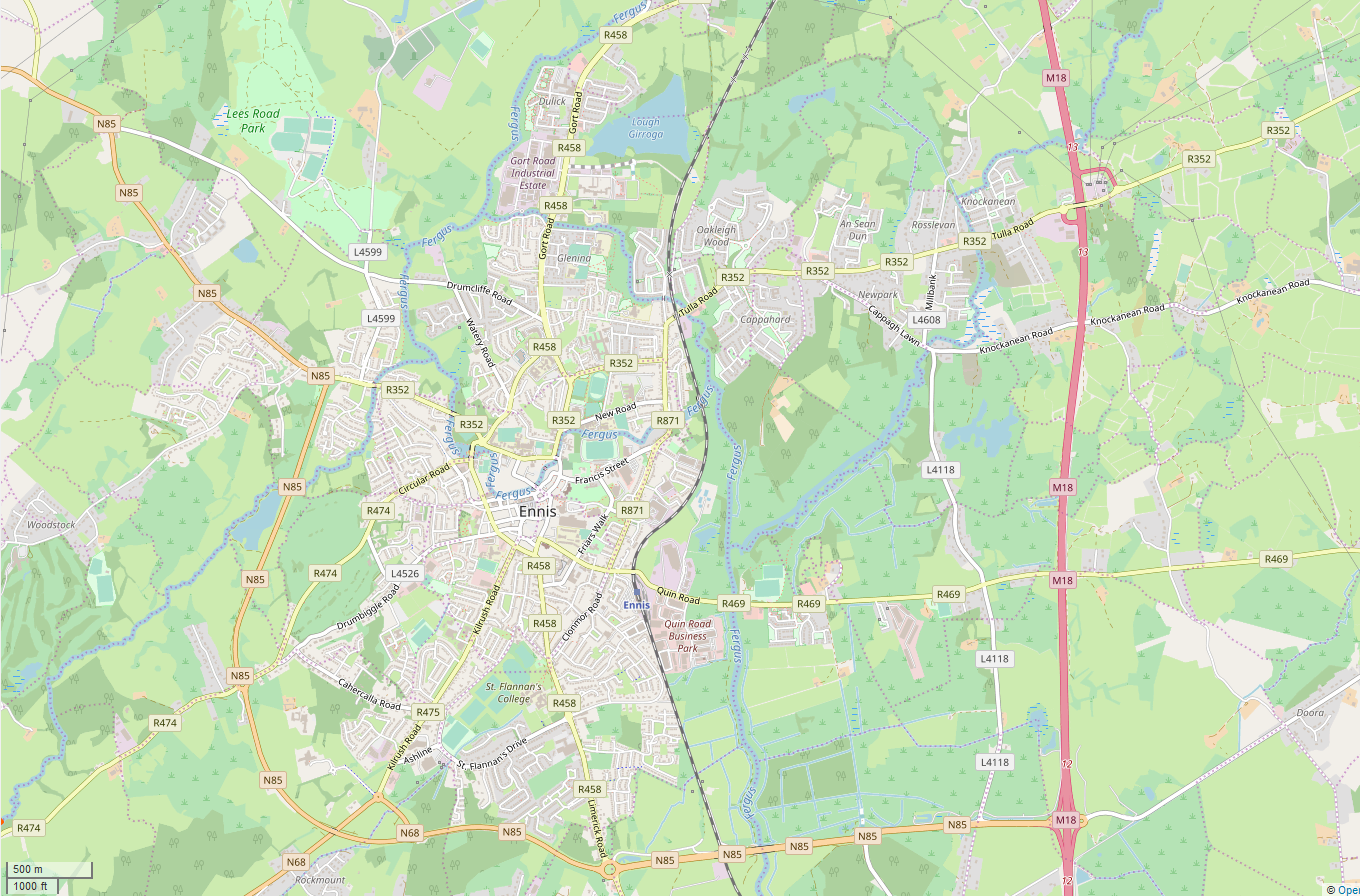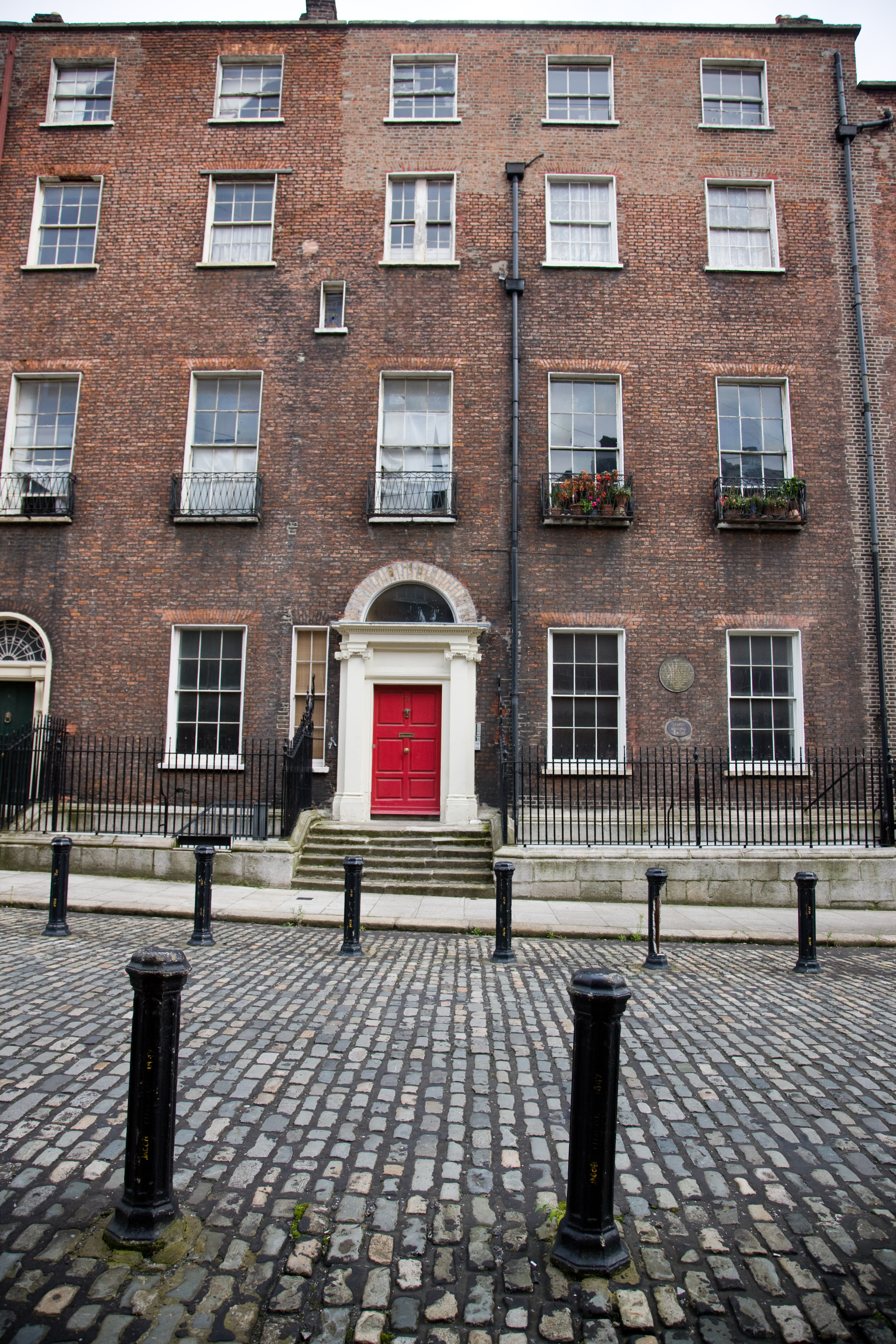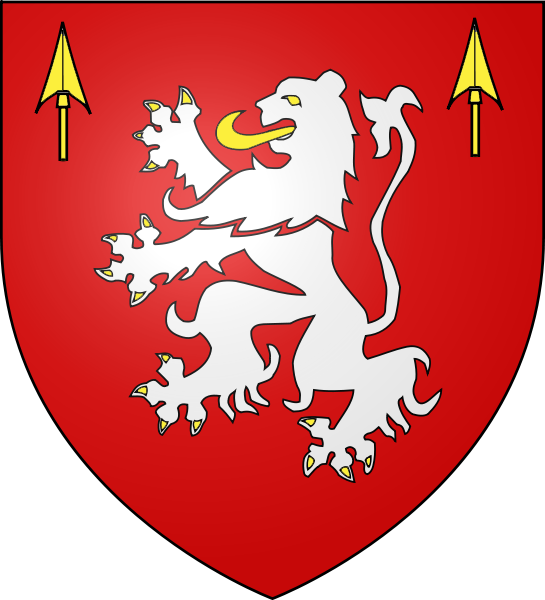|
Bunratty Village
Bunratty (, meaning "mouth of the Raite") is a village in County Clare, Ireland, near Bunratty Castle. It is connected by the N18 road to Limerick and Galway. The Raite river defines the parish's eastern boundary and flows into the Shannon Estuary, which defines the southern boundary. History The first settlement in Bunratty may have been set up by Vikings in the 10th century. The Annals of the Four Masters report that Brian Boru destroyed a Viking settlement in the area in 977. Around 1250 the Anglo-Norman ruler Mucegros was given the right to hold a market and fair at Bunratty. He built the castle in 1277. The castle became the main residence of Richard de Clare, owner of all of Thomond. In the late 13th century, Bunratty had about 1,000 inhabitants. Richard de Clare was killed in 1311, and in 1314 the town of Bunratty was burned to the ground by the local people. The castle was sacked in 1332. The current Bunratty Castle was built by the MacNamara family in the early par ... [...More Info...] [...Related Items...] OR: [Wikipedia] [Google] [Baidu] |
List Of Sovereign States
The following is a list providing an overview of sovereign states around the world with information on their status and recognition of their sovereignty. The 205 listed states can be divided into three categories based on membership within the United Nations System: 193 member states of the United Nations, UN member states, two United Nations General Assembly observers#Current non-member observers, UN General Assembly non-member observer states, and ten other states. The ''sovereignty dispute'' column indicates states having undisputed sovereignty (188 states, of which there are 187 UN member states and one UN General Assembly non-member observer state), states having disputed sovereignty (15 states, of which there are six UN member states, one UN General Assembly non-member observer state, and eight de facto states), and states having a political status of the Cook Islands and Niue, special political status (two states, both in associated state, free association with New ... [...More Info...] [...Related Items...] OR: [Wikipedia] [Google] [Baidu] |
Vikings
Vikings were seafaring people originally from Scandinavia (present-day Denmark, Norway, and Sweden), who from the late 8th to the late 11th centuries raided, pirated, traded, and settled throughout parts of Europe.Roesdahl, pp. 9–22. They also voyaged as far as the Mediterranean Sea, Mediterranean, North Africa, the Middle East, Greenland, and Vinland (present-day Newfoundland in Canada, North America). In their countries of origin, and some of the countries they raided and settled in, this period is popularly known as the Viking Age, and the term "Viking" also commonly includes the inhabitants of the Scandinavian homelands as a whole. The Vikings had a profound impact on the Early Middle Ages, early medieval history of Northern Europe, northern and Eastern Europe, including the political and social development of England (and the English language) and parts of France, and established the embryo of Russia in Kievan Rus'. Expert sailors and navigators of their cha ... [...More Info...] [...Related Items...] OR: [Wikipedia] [Google] [Baidu] |
Great Famine (Ireland)
The Great Famine, also known as the Great Hunger ( ), the Famine and the Irish Potato Famine, was a period of mass starvation and disease in Ireland lasting from 1845 to 1852 that constituted a historical social crisis and had a major impact on Irish society and history as a whole. The most severely affected areas were in the western and southern parts of Ireland—where the Irish language was dominant—hence the period was contemporaneously known in Irish as , which literally translates to "the bad life" and loosely translates to "the hard times". The worst year of the famine was 1847, which became known as "Black '47".Éamon Ó Cuív – the impact and legacy of the Great Irish Famine The population of Ireland on the eve of the famine was about 8.5 million; by 1901, it was just 4.4 million. During the Great Hunger, roughly 1 million people died and more than 1 million more Irish diaspora, fled the country, causing the country's population to fall by 20–25% between 18 ... [...More Info...] [...Related Items...] OR: [Wikipedia] [Google] [Baidu] |
Royal Irish Constabulary
The Royal Irish Constabulary (RIC, ; simply called the Irish Constabulary 1836–67) was the police force in Ireland from 1822 until 1922, when all of the island was part of the United Kingdom of Great Britain and Ireland, United Kingdom. A separate civic police force, the unarmed Dublin Metropolitan Police (DMP), patrolled the capital and parts of County Wicklow, while the cities of Derry and Belfast, originally with their own police forces, later had special divisions within the RIC. For most of its history, the ethnic and religious makeup of the RIC broadly matched that of the Irish population, although Anglo-Irish Protestantism in Ireland, Protestants were overrepresented among its senior officers. The RIC was under the authority of the Dublin Castle administration, British administration in Ireland. It was a quasi-military police force. Unlike police elsewhere in the United Kingdom, RIC constables were routinely armed (including with carbines) and billeted in barracks, and ... [...More Info...] [...Related Items...] OR: [Wikipedia] [Google] [Baidu] |
Kilconry
Kilconry () is a civil parish of County Clare, Ireland, located about northwest of Limerick, west of Shannon on the estuary of the River Shannon. The main village in the area is Ballycalla/Ballcally and it contains the Shannon Golf Club and Shannon Airport. Geography The civil parish of Kilconry lies in the barony of Bunratty Lower. It is in the southern part of the county and is bordered by Kilmaleery to the north and Clonloghan to the east and the River Shannon to the south and west. It is divided into 9 townland A townland (; Ulster-Scots: ''toonlann'') is a traditional small land division used in Ireland and in the Western Isles of Scotland, typically covering . The townland system is of medieval Gaelic origin, predating the Norman invasion, and mo ...s: *Ballycally *Ballyhennessy *Carrigerry *Feenish *Garrynamona *Inishmacnaghtan *Rineanna North *Rineanna South *Stonehall See also * List of townlands of County Clare References {{Civil parishes o ... [...More Info...] [...Related Items...] OR: [Wikipedia] [Google] [Baidu] |
Tomfinlough
Tomfinlough () is a civil parish in County Clare, Ireland. A Christian establishment was first made here around 540 AD. The parish lands were often raided by Irish, Viking, Norman and English forces in the years that followed. The church was allowed to fall into ruins during the period when the Catholic Church was penalized in Ireland. Location The ruined parish church stands at the northern end of the lake named Finn Lough or Fenloe. The name "Tomfinlough" means Tomb or Tumulus of the Fair Lake. It is in the barony of Bunratty Lower in County Clare, about northwest of the village of Six-Mile-Bridge. The parish contains the village of Ardsallis. The parish contains the following townlands: Ayleacotty, Ballycar, Boheraroan, Caherkine, Caherscooby, Carrowmeer, Carrownakilly, Finlough, Granaghan, Granaghan Beg, Granaghan More, Kilnacrandy, Langough, Mausnarylaan, Mooghaun North, Mooghaun South, Muckanagh (Butler), Muckanagh (Studdert), Muckanagh (Vandeleur), Newmarket, Rathl ... [...More Info...] [...Related Items...] OR: [Wikipedia] [Google] [Baidu] |
Ennis
Ennis ( , meaning 'island' or 'river meadow') is the county town of County Clare, in the mid-west of Ireland. The town lies on the River Fergus, north of where the river widens and enters the Shannon Estuary. Ennis is the largest town in County Clare, with a population of 27,923, making it the 6th largest town, and 11th largest urban settlement, as of the 2022 census. Dating from the 12th century the town's Irish name is short for , deriving from its location between two courses of the River Fergus. Ennis has had considerable success in the Irish Tidy Towns competition. In 2005 and 2021, the town was named Ireland's tidiest town, and was named Ireland's tidiest large urban centre on multiple occasions. The town straddles two baronies. Most of the town, including its historic centre, is in the Barony of Islands. However, the eastern and north-eastern edges of the town are in the Barony of Bunratty Upper. History The name Ennis derives from the Irish word "Inis", mea ... [...More Info...] [...Related Items...] OR: [Wikipedia] [Google] [Baidu] |
Earl Of Thomond
Earl of Thomond was an hereditary title in the Peerage of Ireland. It was created twice for the O'Brien dynasty which is an ancient Irish sept native to north Munster. History and background First creation Under the Crown of Ireland Act 1542, King Henry VIII of England was created King of Ireland by the Parliament of Ireland. In consequence, all reigning monarchs and clan chiefs in Ireland were ordered to surrender their native titles in return for peerages. This surrender and regrant offer was conditional upon the adoption of Tudor customs and laws, including pledging allegiance to the Irish Crown and apostatising from the Catholic faith by accepting the articles of the state established Church of Ireland. Through surrender and regrant, the earldom of Thomond was created in 1543 for Murrough O'Brien. He had previously been styled King of Thomond and was descended from the ' or High King of Ireland, Brian Boru. O'Brien was also created Baron Inchiquin, on 1 July 1543. On t ... [...More Info...] [...Related Items...] OR: [Wikipedia] [Google] [Baidu] |
O'Brien Dynasty
The O'Brien dynasty (; ; genitive ''Uí Bhriain'' ) was an Irish Clan and noble house of Munster, founded in the 10th century by Brian Boru of the Dál gCais (Dalcassians). After becoming King of Munster, through conquest he established himself as ''Ard Rí na hÉireann'' (High King of Ireland). Brian's descendants thus carried the name Ó Briain, continuing to rule the Kingdom of Munster until the 12th century where their territory had shrunk to the Kingdom of Thomond which they would hold for just under five centuries. In total, four Ó Briains ruled in Munster, and two held the High Kingship of Ireland (with opposition). After the partition of Munster into Thomond and the MacCarthy Kingdom of Desmond by Tairrdelbach Ua Conchobair in the 12th century, the dynasty would go on to provide around thirty monarchs of Thomond until 1542. During part of this period in the late 13th century they had a rivalry with the Norman de Clare house, disputing the throne of Thomond. The ... [...More Info...] [...Related Items...] OR: [Wikipedia] [Google] [Baidu] |
MacNamara
MacNamara or McNamara ( Irish: ''Mac Con Mara'') is an Irish surname of a family of County Clare in Ireland. According to historian C. Thomas Cairney, the MacNamaras were one of the chiefly families of the Dal gCais or Dalcassians who were a tribe of the Erainn who were the second wave of Celts to settle in Ireland between about 500 and 100 BC. McNamara family The McNamara family were an Irish clan claiming descent from the Dál gCais and, after the O'Briens, one of the most powerful families in the Kingdom of Thomond as Lords of Clancullen (a title later divided into East and West families). They are related to the O'Gradys, also descended from the Uí Caisin line of the Dál gCais. The name began with the chieftain Cumara, of Maghadhair in county Clare. Cumara is a contracted form of Conmara – hound of the sea. His son, Domhnall, who died in 1099, adopted the surname Mac Conmara, or son of Cumara, thus becoming the first of his name. The name has survived relatively un ... [...More Info...] [...Related Items...] OR: [Wikipedia] [Google] [Baidu] |
Thomond
Thomond ( Classical Irish: ; Modern Irish: ), also known as the Kingdom of Limerick, was a kingdom of Gaelic Ireland, associated geographically with present-day County Clare and County Limerick, as well as parts of County Tipperary around Nenagh and its hinterland. The kingdom represented the core homeland of the Dál gCais people, although there were other Gaels in the area such as the Éile and Eóganachta, and even the Norse of Limerick. It existed from the collapse of the Kingdom of Munster in the 12th century as competition between the Ó Briain and the Mac Cárthaigh led to the schism between Thomond ("North Munster") and Desmond ("South Munster"). It continued to exist outside of the Anglo-Norman-controlled Lordship of Ireland until the 16th century. The exact origin of Thomond, originally as an internal part of Munster, is debated. It is generally held that the Déisi Muman pushed north-west starting from the 5th to the early 8th century, taking the area from the ... [...More Info...] [...Related Items...] OR: [Wikipedia] [Google] [Baidu] |
Richard De Clare, Steward Of Forest Of Essex
Richard de Clare (after 1281 – 10 May 1318), 1st Lord Clare, was the son of Thomas de Clare, Lord of Thomond and Juliana FitzGerald. A descendant of Gilbert Fitz Richard de Clare, he succeeded his older brother, Gilbert, in 1308 as Lord of Thomond. In 1309, and then again between 1312 and 1316, he was sheriff of Cork. As part of his duties, he put down a number of rebellions. He was killed while commanding his forces at the Battle of Dysert O'Dea near the modern town of Ennis in County Clare. According to legend, the day before his death, Richard de Clare beheld a woman dressed in white on the river's edge washing bloody clothing and armor. When he asked whose clothes they were, she replied, "yours," and then vanished. This woman was believed to be a banshee foretelling his death. The next day, he lay dead with his clothes caked in blood on the battlefield of Dysert O'Dea. Richard was succeeded in the lordship by his son Thomas, who was born in 1318 and died three years ... [...More Info...] [...Related Items...] OR: [Wikipedia] [Google] [Baidu] |





